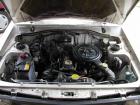The Carbon Canister was fitted first to 1975 USA B210 to capture fumes from the fuel tank. Instead of letting the fumes just to go the atmosphere. In the Canister is an activated charcoal filter. Later when the engine runs, fresh air is drawn through the filter and burned in the engine. Like all 1200s, the fuel tank Filler Cap is not vented. It seals the gas tank well, so that any fumes must go through the vent hose. In the case of EVAPO models, the tank is vented in the engine compartment through a steel Evaporative Fuel Line. Bottom line: makes your Sunny smell good!
Contents |
Overview
Some later 1200s and other Sunnys (B210 & B310) used a charcoal canister bolted to left strut tower. This is what most modern automobiles use to contain and filter the fumes. Instead if a Flow Guide Valve, the fuel tank is vented to the canister. A simple check valve is used (near the fuel tank) to prevent back flow from the engine into the fuel tank.
- All USA B210s from 1975 used a charcoal canister
- Australia B310 Wagon with A15 (all other Aussie B310 uses a Flow Guide Valve)
These system do not use a flow-guide valve. Instead, while engine is running, fumes go to the air cleaner. When engine is off, they are vented to the canister, and the charcoal absorbs the vapors. When the engine is started, the purge line draws air through the canister into the engine, thus drawing the vapors into the engine.
Maintainance
The carbon filter should be replaced at the interval listed in your owner's manual (generally every 2 year or 40,000 km).
System Operation
The canister is bolted to the left strut tower (right side of this photo)

Fuel tank vents to the canister, like this through the Evaporative Fuel Line (tank vent line):
The 1.5-way check valve lets fresh air freely into the tank, but only a little of the fumes from the tank can go back into the engine compartment.
The canister has three lines like this:
- Purge line (to intake manifold)
- Control line (to "ported vacuum" fitting high up on carburetor, perhaps same as EGR port)
- Vent line to tank. Vent line includes the Fuel Check Valve (1.5-way valve)
5-hose Canister
Most 1981 B310 models for North America used a DCH306 version 2.0 carburetor which has a vented fuel bowl.
This externally vented Fuel bowl is goes to a special 5-hose Canister. The canister has a Vent Switching Valve which is open when the engine is not running, so that vapors from the fuel bowl can go directly to the charcoal filter. When the engine starts, vacuum from the intake manifold closes the VSV and the fuel bowl vents as previous through the vent above the choke blade.
4th & 5th hoses Fuel bowl vent line (large diameter) Vacuum from intake manifold (small diameter)
Used by * All USA models * Canada MPG model

![[Datsun 1200 encyclopedia]](/wiki/upload/wiki.png)







